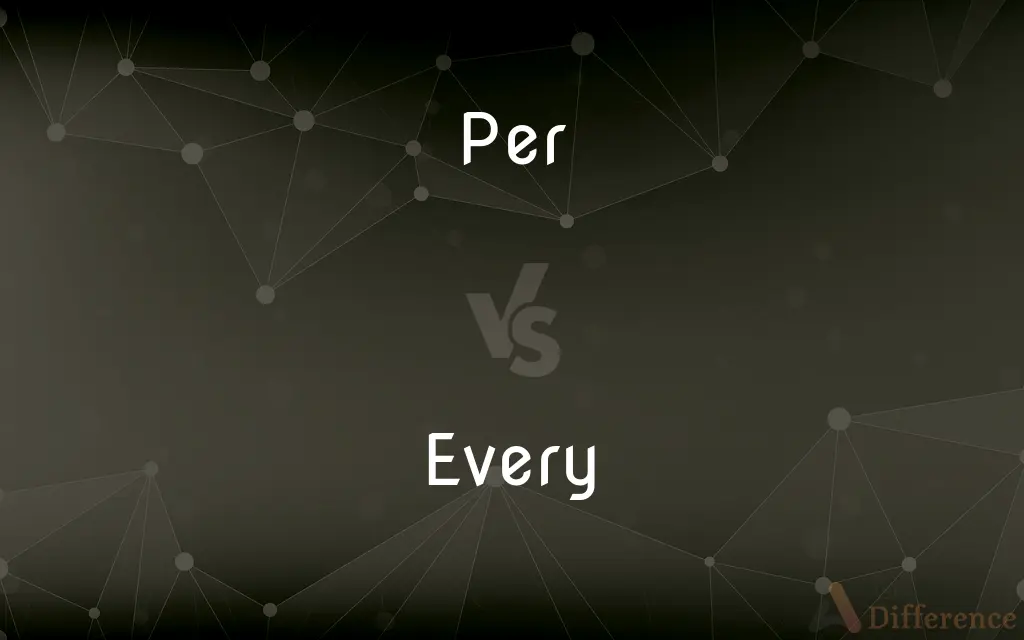Per vs. Every — What's the Difference?
By Fiza Rafique & Urooj Arif — Updated on April 4, 2024
Per implies a rate or distribution, while every denotes each member of a group without exception.

Difference Between Per and Every
Table of Contents
ADVERTISEMENT
Key Differences
Per is used to express a relation between two quantities, indicating distribution or rate. For example, in "miles per hour," it denotes speed as the number of miles in each hour. On the other hand, every refers to each individual member of a group, emphasizing inclusivity, as in "every student must submit their homework."
Per conveys the idea of allocation or proportion, as seen in phrases like "one item per person," suggesting a limit or distribution mechanism. Whereas every highlights uniformity or universality within a group, ensuring no entity is excluded, such as in "every piece of artwork is unique."
In legal or formal documents, per is often used to denote authorization or according to, like "as per the agreement," indicating conformity with the stipulated terms. Every, however, is used to signify each occurrence or instance within a specified context, reinforcing the idea of totality or completeness.
Per can also indicate a method of measurement or standard, such as "per annum" for yearly. Every, in contrast, is more absolute, stressing individual attention or consideration, like "every year," which refers to each year without fail.
While per is more applicable in scenarios requiring measurement, proportion, or allocation, every is used to assert totality, ensuring that no part of a group is overlooked. This distinction is crucial in both practical applications and semantic precision.
ADVERTISEMENT
Comparison Chart
Definition
Indicates a rate, distribution, or proportion.
Denotes each member of a group individually.
Context of Use
Measurement, allocation, formal agreements.
Inclusivity, uniformity, individual attention.
Implied Meaning
Allocation or proportion per unit.
Totality or completeness within a group.
Example Usage
"Calories per serving" signifies nutritional information distributed over servings.
"Every vote counts" emphasizes the importance of each individual vote.
Semantic Emphasis
Measurement or standardization.
Inclusiveness and universality.
Compare with Definitions
Per
According to; used to refer to something as per a rule or agreement.
As per your request, we've updated the document.
Every
Each without exception; used to refer to all members of a group individually.
Every student must complete the assignment.
Per
By means of; used to denote the means or medium.
Send the package per express mail.
Every
Used to indicate frequency or repetition.
The meeting is held every Monday.
Per
For each; used to express a rate or ratio.
She is paid per hour.
Every
Emphasizes the importance of each individual item or instance.
Every piece of feedback is valuable to us.
Per
Through the agency or means of; formally specifying authority.
Signed per the director's approval.
Every
Signifies inclusivity in a specified range or group.
Every color of the rainbow is unique.
Per
For every instance of; indicating distribution.
Per our policy, only one coupon can be used per purchase.
Every
Denotes regularity or without exception in occurrence.
He calls her every day without fail.
Per
For each (used with units to express a rate)
He charges £2 per square yard
Every
Constituting each and all members of a group without exception.
Per
By means of
Send it per express
Every
Being all possible
Had every chance of winning, but lost.
Per
Divided by a line in the direction of
Per saltire
Every
Being each of a specified succession of objects or intervals
Every third seat.
Every two hours.
Per
To, for, or by each; for every
Gasoline once cost 40 cents per gallon.
Every
Being the highest degree or expression of
Showed us every attention.
Had every hope of succeeding.
Per
According to; by
Changes were made to the manuscript per the author's instructions.
Every
Of a countable group (considered individually), without exception.
Every person in the room stood and cheered.
Per
By means of; through.
Every
Denotes equal spacing at a stated interval, or a proportion corresponding to such a spacing.
We stopped for refreshments every ten miles.
The alarm is going off every few minutes.
Every third bead was red, and the rest were blue. The sequence was thus red, blue, blue, red, blue, blue etc.
Decimation originally meant the execution of every tenth soldier in a unit; that is, ten per cent of soldiers were killed.
Per
For each one; apiece
Sold the cookies for one dollar per.
Every
(with certain nouns) Denotes an abundance of something.
We wish you every happiness in the future.
I have every confidence in him.
There is every reason why we should not go.
The police will make every effort to trace the missing girl.
Per
Per hour
Was driving at 60 miles per.
Every
All the parts which compose a whole collection or aggregate number, considered in their individuality, all taken separately one by one, out of an indefinite number.
Every man at his best state is altogether vanity.
Every door and window was adorned with wreaths of flowers.
Per
For each.
Admission is £10 per person.
Miles per gallon
Beats per minute
$2.50 per dozen
Every
Every one. Cf. Each.
Daily occasions given to every of us.
In each division there were four pentecosties, in every pentecosty four enomoties, and of each enomoty there fought in the front rank four [soldiers].
If society is to be kept together and the children of Adam to be saved from setting up each for himself with every one else his foe.
Per
To each, in each (used in expressing ratios of units).
12 inches per foot
100 centimeters per meter
Every
Each and all of a series of entities or intervals as specified;
Every third seat
Every two hours
Per
(medicine) By the, by means of the, via the, through the.
Introduce the endoscope per nasum.
The medication is to be administered per os.
Every
(used of count nouns) each and all of the members of a group considered singly and without exception;
Every person is mortal
Every party is welcome
Had every hope of success
Every chance of winning
Per
In accordance with, as per
I parked my car at the curb per your request.
Implement a program that computes the approximate grade level needed to comprehend some text, per the below.
Note that while the walkthrough illustrates that words may be separated by more than one space, you may assume, per the specifications above, that no sentences will contain more than one space in a row.
Per
They singular. Gender-neutral neologistic third-person singular subject pronoun, coordinate with gendered pronouns she.}}
Per
Them singular Neologistic gender-neutral third-person singular object pronoun, suggested for use in place of her.}}
Per
Belonging to per, their singular. Gender-neutral third-person singular possessive adjective, coordinate with gendered her.}}
Per
Through; by means of; through the agency of; by; for; for each; as, per annum; per capita, by heads, or according to individuals; per curiam, by the court; per se, by itself, of itself. Per is also sometimes used with English words.
Common Curiosities
How does every affect the meaning of a sentence?
Every emphasizes totality and individual attention, ensuring that each member of a group is considered without exception.
Can every be used for things not physically counted?
Yes, every can refer to abstract or non-countable items when emphasizing inclusivity.
Does every imply a limit or quantity?
Every does not imply a limit; instead, it emphasizes inclusivity and consideration of each individual member of a group.
Can per be used to indicate time periods?
Yes, per can denote frequency within a time period, such as "per year" or "per hour."
What does per mean in measurements?
Per indicates a ratio or rate, such as units per quantity in measurements.
Is per used only in mathematical contexts?
No, per is used in various contexts, including legal, formal, and everyday language, to denote rates, according to agreements, or means.
Can per and every be used interchangeably?
No, they serve different purposes: per relates to rates or distribution, while every emphasizes individual inclusivity within a group.
What does "as per" imply in communication?
"As per" implies conformity or accordance with something specified, such as instructions or agreements.
What is the significance of using per in financial contexts?
In financial contexts, per is used to indicate rates, proportions, or conditions that apply to transactions or agreements.
How does every interact with plural nouns?
Every precedes singular nouns but implies a collective or plural concept by addressing each member of a group individually.
Is every always followed by a singular noun?
Yes, every is typically followed by a singular noun, reinforcing the idea of individual members of a group.
How does the use of every impact the tone of instructions?
Using every in instructions emphasizes the importance and necessity of compliance or action by each individual involved.
Can the use of per or every change the interpretation of data or facts?
Yes, per can influence the understanding of distribution or ratio, while every affects the perceived inclusivity or totality of the data or facts presented.
Is per more formal than every?
Per can be more formal, especially in legal, academic, or professional contexts, compared to the more universally accessible every.
How do per and every differ in legal documents?
Per often relates to stipulations or conditions ("as per the agreement"), while every may specify the inclusivity of terms applied to all parties or conditions.
Share Your Discovery

Previous Comparison
Dignity vs. Esteem
Next Comparison
Makhaira vs. SwordAuthor Spotlight
Written by
Fiza RafiqueFiza Rafique is a skilled content writer at AskDifference.com, where she meticulously refines and enhances written pieces. Drawing from her vast editorial expertise, Fiza ensures clarity, accuracy, and precision in every article. Passionate about language, she continually seeks to elevate the quality of content for readers worldwide.
Co-written by
Urooj ArifUrooj is a skilled content writer at Ask Difference, known for her exceptional ability to simplify complex topics into engaging and informative content. With a passion for research and a flair for clear, concise writing, she consistently delivers articles that resonate with our diverse audience.
















































